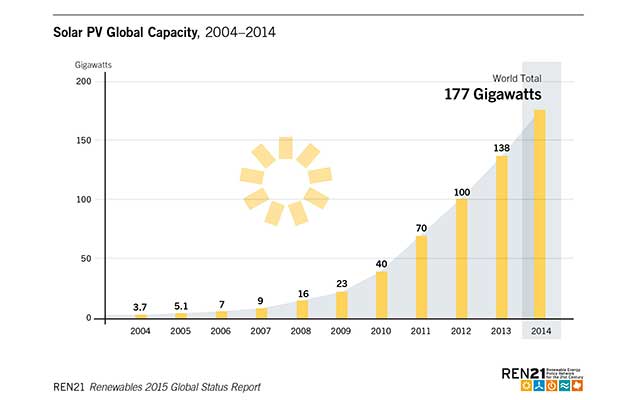Last year, 59 percent of capacity addition in the global
power industry came from renewable energy. Also, the number of countries with
renewable energy targets rose to 164 — an increase by 20 — in the year. The
sector received an overall investment of $301 billion.
The findings were part of Worldwatch Institute–Renewable
Energy Policy Network for the 21st Century (REN21) annual Renewables Global
Status Report (RGSR). The report was released recently at the Vienna Energy
Forum.
Worldwatch is an independent research organization based in
Washington DC and REN21 is a global renewable energy policy multi-stakeholder
network.
According to the RGSR, 135 gigawatts of renewable energy
capacity was added globally last year, taking the total installed capacity of
renewables to 1,712 gigawatts.
The figure was an increase of 8.5 percent from the year
before and for the “first time in four decades the world economy grew without a
parallel rise in CO2 emissions”.
Although the world’s average annual energy consumption
continued to increase at 1.5 percent and GDP grew at average 3 percent, carbon
dioxide (CO2) emissions in 2014 were unchanged from 2013 levels, the RGSR
notes.
The global reduction in greenhouse gas has been attributed
in large measure to an increased use of renewable resources in China. Also
countries in the OECD are promoting more sustainable growth, including the
increased use of energy efficiency and renewable energy.
An observation in the report is that at least 145 countries
now have supportive policies for the development of renewable energy, which is
an increase from the 138 countries reported in the previous year. Wind,
solar photovoltaic (PV), and hydro sources together increased capacity by 128
GW from the levels in 2013.
The growth took the share of renewable energy capacity in
the global energy mix to 27.7 percent toward the end of 2014. It is estimated
to be adequate to supply an estimated 22.8 percent of global electricity
demand.
And compared with levels in 2004, the solar PV sector has
shown capacity addition at the rate of 48 times from 3.7 GW to 177 GW. Wind
power capacity, meanwhile, showed nearly 8-fold increase over the same period
from 48 GW to 370 GW.
According to the RGSR, new investment in global renewable
power and fuels sector excluding hydropower projects above 50 MW capacity
increased by 17 percent over 2013. The investment touched $270.2 billion.
Also developing countries contributed $131.3 billion to the
development of renewables, which is a 36 percent increase from the previous
year. Developed countries invested $138.9 billion in 2014, up only 3 percent
from 2013.
RGSR notes that among developing countries clean energy
development by China accounted for 63 percent of the global investment. And
Chile, Indonesia, Kenya, Mexico, South Africa and Turkey each invested more
than $1 billion in renewable energy.
Christine Lins, the executive secretary of REN21, said:
“Creating a level playing field would strengthen the development and use of
energy efficiency and renewable energy technologies. Removing fossil-fuel and
nuclear subsidies globally would make it evident that renewables are the
cheapest energy option.”
The renewables sector has also led to a concomitant increase
in employment. In 2014, about 7.7 million people worldwide worked directly or
indirectly in the sector.


No comments:
Post a Comment